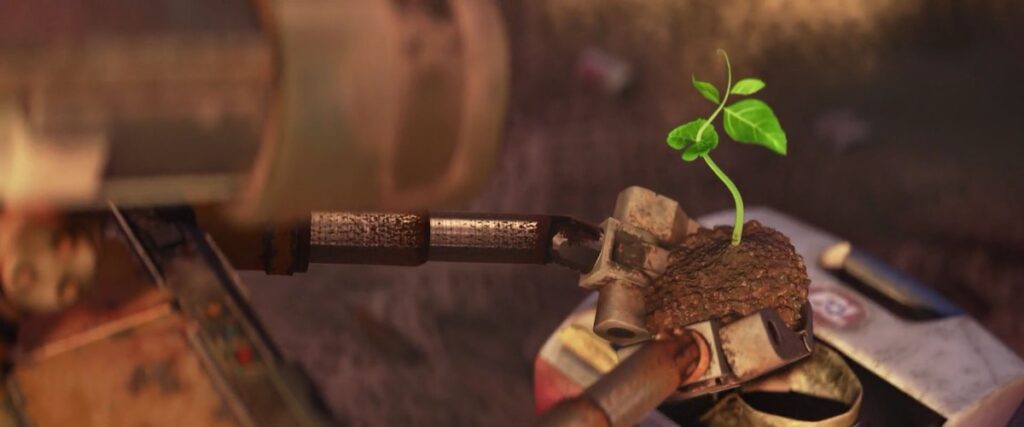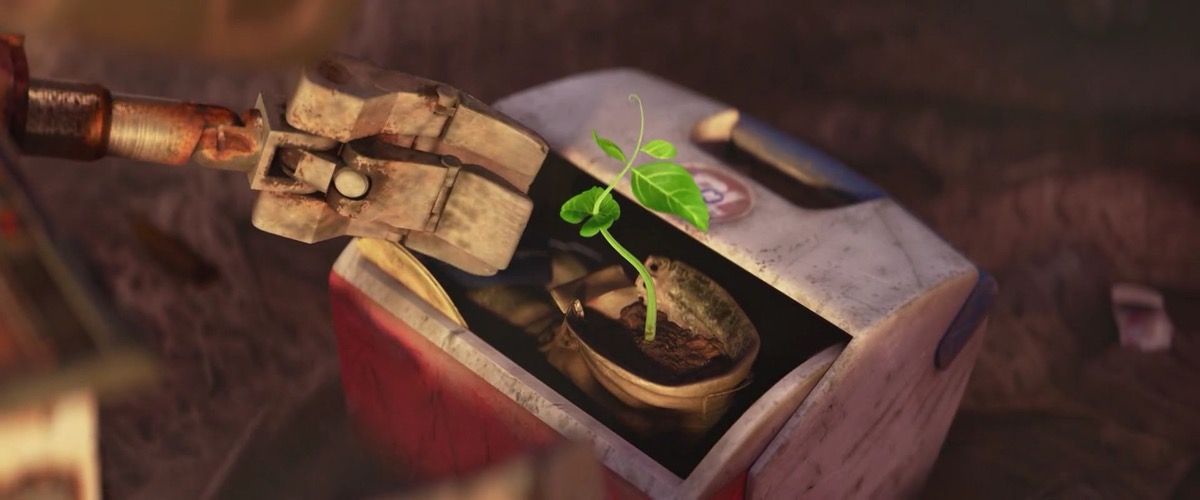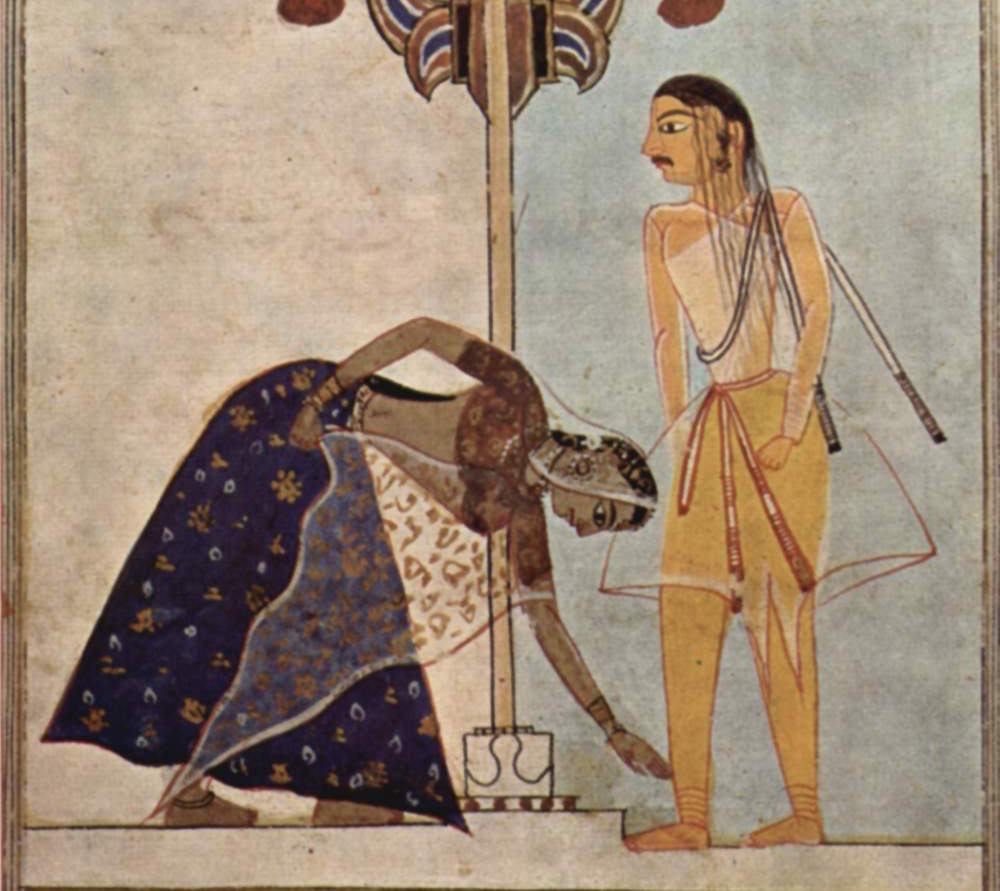In a world marked by suffering, war, and violence, where the egos of authoritarian leaders reign, it can be challenging to find Easter joy. We are left with a question: How can we hold on to hope and celebrate the resurrection in the face of such darkness? I imagine that Jesus’ followers felt a similar sense of despair and hopelessness after witnessing the brutal violence of his torture and crucifixion. Yet, the invitation of the Christian story and the Easter narrative is to hold space for both the pain and darkness of Good Friday and the hope and resurrection of Easter Sunday. True Easter joy isn’t about ignoring the suffering and harsh realities of the world; rather, it is about believing and trusting in the possibility of new life emerging from even the darkest places. As Jesus said, “In this world you will have trouble. But take heart! I have overcome the world” (John 16:33).
 Seeming Death and Darkness
Seeming Death and Darkness
The movie WALL-E might seem like an unlikely candidate for an Easter story but it has something to say to my question of hope amidst darkness. Set in a dystopian future where the Earth has been rendered uninhabitable due to pollution and waste, the film follows the journey of a lonely robot tasked with cleaning up the mess left behind by humanity. Yet, beneath the surface, WALL-E is a powerful tale of resurrection and hope that echoes the very heart of the Easter message.
In the beginning of the movie, we’re presented with a bleak and lifeless landscape. The Earth is covered in garbage, and the only signs of life are the resilient cockroaches that scuttle among the debris. Humans have retreated into space, and after 700 years, it appears that no one will ever return. The earth is dead, and the once-flourishing planet filled with life, joy, and culture is now a distant memory. WALL-E spends his days compacting trash and collecting the few treasures he finds among the waste. It’s a seemingly hopeless existence, not unlike the despair that the disciples must have felt on Good Friday and Holy Saturday.
 New Life
New Life
But just as the Easter story doesn’t end with the crucifixion, WALL-E’s journey doesn’t end with the desolation of Earth. One day, he discovers a single, fragile plant growing out of the wasteland, a sign of life that holds the promise of a future beyond the current devastation. This small, green shoot is a reminder that even in the darkest of times, hope can still take root and flourish. WALL-E’s tender care for the plant mirrors the way in which we must nurture the seeds of hope in our own lives, even when the world around us seems to be crumbling. This echoes Jesus’ words in John 12:24, “Very truly I tell you, unless a grain of wheat falls to the ground and dies, it remains only a single grain. But if it dies, it produces much fruit.”
Life is Resilient
The parable of WALL-E is a powerful reminder of the resilience of life. WALL-E’s love for the plant sets in motion a series of events that ultimately lead to the restoration of Earth and the return of humanity. The parallels to the Easter narrative are striking – just as Jesus’ resurrection brings the promise of new life and redemption, WALL-E’s discovery of the plant sparks a chain reaction of renewal and rebirth. The theme of resurrection is woven throughout the film, from the transformation of EVE, the robot sent to Earth to search for signs of life, to the regeneration of Earth’s ecosystem. It reminds us that even when all seems lost, there is always the potential for new beginnings. Indeed, the natural world itself reveals an inherent hope and resilience. Certain animals can regenerate, plants die and return to life, and entire ecosystems can remarkably regenerate after destruction. And just as the Easter story represents a cycle of death and resurrection, we can observe similar patterns in the world around us. Seasons change, tides rise and fall, and day gives way to night, only to begin anew each morning. By recognising and embracing these cycles, we can develop a greater appreciation for the ebbs and flows of our own lives, knowing that even the darkest of times will eventually give way to light. As the painter Bob Ross once wisely said, “You have to have dark in order to show light.”
 Even Saint Ignatius’ story of a debilitating battle wound showcases a resilience and a new life that emerges from the power of God’s spirit breaking through desolation. Easter hope doesn’t mean denying the world’s pain and brokenness. We must acknowledge it honestly. But we must also remain open to the possibility of resurrection and new life.
Even Saint Ignatius’ story of a debilitating battle wound showcases a resilience and a new life that emerges from the power of God’s spirit breaking through desolation. Easter hope doesn’t mean denying the world’s pain and brokenness. We must acknowledge it honestly. But we must also remain open to the possibility of resurrection and new life.
For many, faith serves as a bedrock of hope during trying times. In moments of desperation, people often turn to God or their spiritual beliefs for comfort. The Easter story, with its themes of sacrifice, resurrection, and renewal, resonates deeply with those seeking hope amidst hardship. By leaning into faith and the promise of new life, we can find the courage to persevere and trust in the possibility of better days ahead.
In the end, WALL-E is a testament to the resilience of life and the enduring power of love. It’s a reminder that, no matter how dark and hopeless things may seem, there is always the possibility of resurrection. Just as the Easter story gives us the courage to face the challenges and trials of life, knowing that death has been conquered, WALL-E inspires us to hold onto hope and to believe in the transformative power of love.
Related posts:
Listen to the podcast version of this post…








